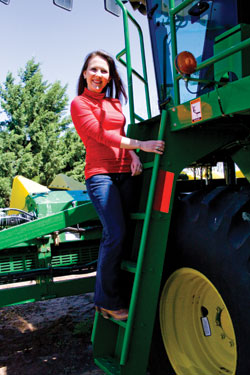Why Choose When You Can Do Both?
Story and Photos by Koreley Holubec
Each semester, more than 100 students graduate from the Texas Tech School of Medicine. After May 22, 2010, Ashley Sturgeon will join those students. Setting her apart from the pack is Sturgeon’s undergraduate degree in animal science and her practical experiences that came with it.
Sturgeon’s involvement in agriculture from a young age, paired with a desire to go to medical school, led her to pursue an undergraduate degree in Texas Tech’s Animal and Food Science Department.
“I was really involved in agriculture. I told my agri-science teacher how much I loved it and wanted to do it in college. I would qualify for a Houston scholarship if I majored in agriculture,” Sturgeon said. “I wanted to do animal science like my dad, but I really wanted to go to medical school.”
Sturgeon soon learned that she could do both—obtain a degree in animal science and go to medical school.
“You are as qualified, and sometimes more qualified, than people who take a traditional pre-med biology route because of the practical applications,” Sturgeon said. “It is one thing to memorize facts about biology, but it is another to practice and utilize biological mechanisms like we do in medicine every day.”
Sturgeon said she remembered manipulating the reproductive cycle of a cow to produce convenient calving. “I learned how to manipulate the reproductive cycle before I even went to medical school and before I even listened to an OBGYN lecture,” Sturgeon said.
Beyond the experiences of practical applications, there were other perks that drew her to the animal science department. “The practical applications prepared me best for medical school, but I think my journey to medical school through animal science was meant to be,” Sturgeon said. “What was normally very stressful was made much less stressful because I was in the school of ag with supportive advisors who really believed in me.”
“I knew every one of my professors on a personal basis,”
Sturgeon said. “Only some of that was because of my own initiative. A lot of it was because professors made an effort to get to know me.”
Sturgeon said the College of Agricultural Sciences and Natural Resources has an extremely strong counseling and guidance effect and the faculty really made things easier on her, where she wasn’t sure it would have been that easy had she not majored in agriculture.
During her undergraduate program, Sturgeon was also involved in extra-curricular activities that played a major role in preparing her for medical school. “The wool judging team was very influential. It taught me to think on my feet and to think quickly,” Sturgeon said.
“I learned how to make a prompt, informed, and accurate decision about wool. The ability to make effective decisions still helps me in medical school today.” Sturgeon said in medical school she must choose a specific plan for a patient while being able to justify that plan to herself and her attending physician.
“My public speaking and leadership skills also came from opportunities that I had in agriculture,” Sturgeon said. “Presenting reasons in wool judging is similar to explaining my treatment plan for a patient in the clinic.”
Numerous leadership opportunities are available through other pre-med options, some of which Sturgeon also participated in. However, she said she felt she was exposed to diverse, but beneficial extracurricular activities, such as wool judging, more easily because she was in CASNR.
Now that Sturgeon has almost completed her medical degree, she still uses skills she learned during her undergraduate studies to relate to her patients. “The culture of animal science is very much like the culture of West Texas,” Sturgeon said. “I still get the culture of West Texas people across the street at the Health Sciences Center.”
Sturgeon said she does miss being around a group of people who know and understand what the price of cotton or amount of rainfall means for her family.
Sturgeon said her agricultural background allows her to relate better to other people in the agricultural environment and West Texas. “Without animal science, I would have had to work harder to be a good medical student,” Sturgeon said. “My degree gave me a lot of practical experience and it improved my communication skills.” Sturgeon said she felt the animal science environment gave her a warm, friendly feeling of home that made the college experience a lot easier.
Many students do not realize the possibilities of earning both a degree in animal science and their desired medical degree. Sturgeon is living proof that a student majoring in animal science can advance to pre-professional school, without prolonging an undergraduate degree.
Kendra Pond also stressed her belief in using animal science as a doorway to a pre-medical field. Pond is an animal science major with science option, which allows her to take all prerequisite sciences for medical school. Pond was on the track to go to pre-medical school and changed her mind after taking an internship. “The good thing about animal science with the science option is that usually pre-professional required sciences are usually the same,” Pond said.
Pond comes from an agriculture background and a fifth generation cattle ranch. The opportunity for Pond to major in animal science with an emphasis in science allows her to combine her two passions of agriculture and medicine. Pond said she has met and watched several people go through this degree plan and complete it successfully.
Both Sturgeon and Pond have used the animal science department to their advantage and a gateway to the medical field.
Students who are interested in obtaining a medical degree do not have to choose between agriculture and medicine. Students can use CASNR to their advantage and earn a useful undergraduate degree, which will prepare them for situations both in and out of the medical field.